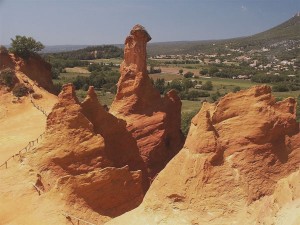The Aboriginal Ochre Wars
At one time, all of Australia was a huge network of trading posts. And good ochre pigment was one of the most prized items to trade. “Wilga Mia” in Western Australia is one of the most sacred ochre mines on the continent. If you want to collect any you have to ask permission from the traditional aboriginal owners and also from the sacred beings who live beneath it’s ancient chambers. It was still being mined and traded in the 1980’s, although by the end of the 20th century it was being collected in plastic buckets instead of bark dishes.
In the Flinders Ranges of South Australia, there’s another famous ochre deposit. For thousands of years Aboriginal expeditions (70-80 men) would walk for two months to travel the thousand- mile round trip to collect their red-gold ochre at a place called Parachilna. They would return with 20 kilos of ochre each in possum or kangaroo skin bags, and on their heads they’d carry huge grinding stones from a nearby stone quarry.
Then in 1860, guess what happened, you guessed it, the white guys arrived. Farmers arrived with land and sheep ownership claims and obviously didn’t want the Aboriginals to eat their sheep or walk across their land. But the natives continued to take sheep meat for their journey and walk across their land which soon became punishable by hanging. In 1863 there was an “ochre massacre” when scores of Aboriginals were killed by angry settlers. Then someone from the South Australian administration suggested a solution! They decided to “move the mine to the Aboriginals” so they wouldn’t have to make the journey. But they moved the wrong mine. They removed four tons of ochre from a mine owned by another tribe on the coast and spent weeks hauling it back. It was a completely wasted effort because the Aborigines wanted none of it.
The white settlers missed the point that it was a pilgrimage involving elaborate ceremonies in collecting the ochre and bringing it back. Also, the sacred ochre was essential for trading which happened when one item is seen as equal in value to another. But free ochre had no value. And lastly, the sacred ochre was used for painting ritual designs and this other ochre from the coast was not good enough or sacred enough and didn’t contain the hint of mercury that made it sparkle.
- From “Color” by Victoria Finlay

